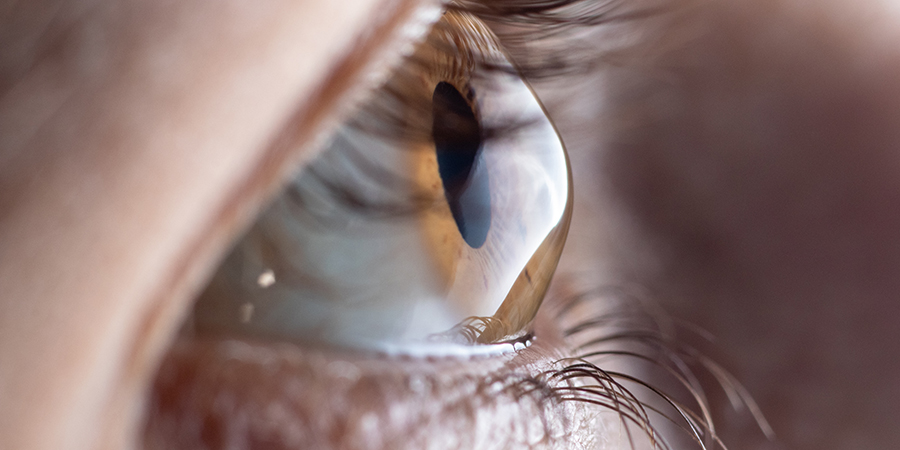
Keratoconus

Keratoconus, or conical cornea, is a condition in which the normally round shape of the cornea is distorted and a cone-like bulge develops, leading to progressive thinning, irregular astigmatism and significant visual impairment. Keratoconus is a bilateral and progressive eye disease. According to the International Keratoconus Foundation, the disease affects 3-5 out of 1,000 people worldwide.

Keratoconus most often shows up in young people at puberty or in their later teen years (15-17) and usually progresses until the age of 30-35, although in some cases the disease progresses until the age of 40.
The exact cause of keratoconus is currently unknown, but possible risk factors include:
- Genetic predisposition;
- Susceptibility to allergies;
- Mechanical trauma (eye-rubbing);
- Long-term and incorrect use of contact lenses;
- Exposure to ultraviolet radiation from the sun.
Dry Eye Disease (DED), which usually develops as a result of partial or complete blockage of the meibomian gland ducts located in the thickness of the eyelid, may contribute to the development of the Keratoconus.
The main symptoms of keratoconus are the following:
- A relatively rapid decrease in visual acuity;
- The frequent need to change prescription for glasses and/or contact lenses;
- The development of “false” myopia and/or astigmatism, which are difficult to correct with glasses or soft contact lenses;
- Increased light sensitivity;
- Symptoms of the “glare” and “halo”;
- Symptoms characteristic to the Dry Eye Disease.

Normal vision (left) and vision with Keratoconus (right)
Early diagnosis and proper treatment of the Keratoconus are very important to stop progression of the disease and prevent possible complications. A detailed medical history and relevant ophthalmic examinations are required for the correct and timely diagnosis of the disease. Although, classic ophthalmic devices and basic ophthalmic examinations might be useful for the diagnosis of the disease, sometimes Keratoconus at the early stages can only be diagnosed by corneal topography. Modern corneal topographers are “Gold Standard” for the Keratoconus diagnosis as they provide the ophthalmologist with the detailed data of various corneal parameters (corneal curvature, thickness, characteristics of both the anterior and posterior surfaces).
Keratoconus treatment is only surgical and is aimed at stopping progression of the disease. At stages I-II of the disease Corneal Cross-Linking (CCL) is recommended, at stages II-III – implantation of the Intrastromal Corneal Ring Segments (ISCR) and at stage IV – in advanced cases when due to the thin cornea (less than 400 microns) above-mentioned treatment methods aren’t indicated, the only treatment is lamellar or penetrating keratoplasty.
Two elements are involved in the Corneal Cross-Linking process: ultra violet irradiation and vitamin B2, also known as riboflavin. A solution of vitamin B2 is administered topically to the cornea and then activated by ultraviolet-A light. The effect of UVA light on the riboflavin creates new bonds between collagen fibrils in the stroma, conferring new mechanical strength on the cornea and stopping disease progression.

Corneal Cross-Linking for Keratoconus Treatment
Implantation of the Intrastromal Corneal Ring Segments is another proven Keratoconus Treatment method. 1 or 2 PMMA (polymethylmethacrylate) segments are implanted in the deep peripheral corneal stroma to modify the corneal curvature. This method not only stops the progression of the disease but also quite often provides visual rehabilitation.

Intrastrormal Corneal Ring Segment – before the implantation (left) and after the implantation (right)
Corneal transplantation (lamellar or penetrating) is usually performed at stage IV keratoconus. During the procedure the patient's cornea is replaced with a donor cornea. Since the cornea is a avascular structure of the eye, the risk of complications is significantly lower compared to the other organ transplantations.

Corneal transplantation at stage IV Keratoconus
(the image is taken before the stitch removal)
All of the above-mentioned procedures are performed on an outpatient basis, most often under topical anesthesia. The postoperative rehabilitation period is quite short, after which the patient can return to his usual daily activities.
Following the disease stabilization for the vision correction Phakic Intraocular Lens (ICL) implantation or scleral lens prescription might be considered. Phakic Intraocular Lenses are calculated individually for each patient and the implantation process is completely painless. Following the ICL implantation the visual acuity drastically improves immediately and for this reason the patients called it “Magic” Lens.

Phakic „Magic“ Lens – ICL Schematic Illustration
Scleral lenses are manufactured individually, based on the parameters of each eye.

Scleral Lens – Schematic Illustration
Therefore, if the reason of the decreased visual acuity is Keratoconus, our clinic offers cutting-edge technologies for the diagnosis and treatment of the disease. Following the complete ophthalmic examination based on the stage of the disease the appropriate treatment method is chosen individually in each clinical case.



 19 Levan Mikeladze St.
19 Levan Mikeladze St.
 info@akhalimzera.ge
info@akhalimzera.ge